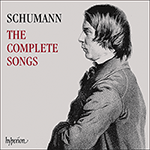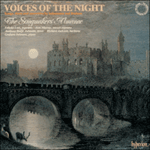
Welcome to Hyperion Records, a British classical label devoted to presenting high-quality recordings of music of all styles and from all periods from the twelfth century to the twenty-first.
Hyperion offers both CDs, and downloads in a number of formats. The site is also available in several languages.
Please use the dropdown buttons to set your preferred options, or use the checkbox to accept the defaults.

Schumann’s poetic source for Minnespiel was the first volume of six in Rückert’s Gesammelte Gedichte printed in Erlangen by the firm of Carl Heyder; this initial instalment was issued in 1836. A large portion of the volume is given over to the same Liebesfrühling poems in five sections (or ‘Sträuße’, each being a huge poetic garland or bouquet) that had been the source of Schumann’s Op 37 songs from 1841 recorded much earlier in the Hyperion series, as well as texts in the Op 25 Myrten: Widmung, the two Lieder der Braut, and Zum Schluss.
The composer seems to have searched far and wide within these many poems for his purposes (see the outline below). From the musical point of view he has clearly gone to some trouble to tie this music together in terms of the progression of tonalities. The work begins and ends in G major with substantial C major pieces at either end of the cycle to reinforce the plagal or religious aspect of a work where marriage represents a holy commitment. The central songs move into the flat keys and return to C and G major via a single song in a minor key. The keys for the individual songs are given below; taken together they make an exemplary tonal scheme for a work of this kind:
(i) Meine Töne still und heiter and Die Liebste hat mit Schweigen (two separate poems joined into a single song) are Nos V and IV of a vast 85-poem ‘Zwischenspiel’ (Interlude) rather strangely placed within the body of the second section of Liebesfrühling (‘Zweiter Strauß’) which in itself has 55 numbered poems (pp.278–9); G major (first poem) and C major (second poem).
(ii) Liebster, deine Worte stehlen is No XXXVIII of the first section (‘Erster Strauß’), pp.232–3; after the line of introductory recitative the key is G major.
(iii) Ich bin dein Baum is No XLIII of the same section as (ii) above, p.235; E flat major.
(iv) Mein schöner Stern! is No XXIV of the ‘Zweiter Strauß’, p.253; E flat major (with a deliberately delayed arrival in the tonic).
(v) Schön ist das Fest des Lenzes is No V of the third section (‘Dritter Strauß’), p.271; B flat major.
(vi) O Freund, mein Schirm, mein Schutz! is No LIV of the fourth section (‘Vierter Strauß’), p.423; G minor.
(vii) Die tausend Grüße is No XVI of the ‘Zweiter Strauß’, p.246–7; C major.
(viii) So wahr die Sonne scheinet is No XVIII of the ‘Erster Strauß’, p.222; G major.
from notes by Graham Johnson © 2009
extrait des notes rédigées par Graham Johnson © 2010
Français: Marie-Stella Pâris
aus dem Begleittext von Graham Johnson © 2010
Deutsch: Henning Weber
 Schumann: The Complete Songs Schumann: The Complete SongsSchumann’s songs are among the greatest musical achievements of the nineteeth century, and this marvellous collection comprises Schumann’s complete songs, presented for the first time in their chronological sequence of composition, with complete s ...» More |
 Brahms & Schumann: Voices of the Night Brahms & Schumann: Voices of the Night‘A very special experience’ (The Daily Telegraph) ‘Immaculate … delicious’ (Hi-Fi News)» More |

